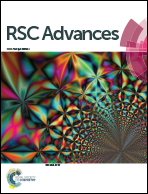Interaction between CO2 and ionic liquids confined in the nanopores of SAPO-11†
Abstract
A series of ionic liquids (P4,4,4,6BF4, APMIMBF4, P4,4,4,6Triz, as well as the newly prepared anion dual-functionalized amino-triz IL P4,4,4,6ATriz, etc.) supported on glass powder and SAPO-11 were prepared, and their interaction with CO2 was investigated by “limited” temperature-programmed desorption. The results showed that the strength of the interaction of CO2 with IL/glass powder (11 wt%) followed the order P4,4,4,6BF4 < APMIMBF4 < P4,4,4,6Triz < P4,4,4,6ATriz. Two desorption peaks were observed for P4,4,4,6Triz, probably attributed to the two sites of interaction between Triz and CO2, and the Gaussian 03 program was employed to obtain the optimized structures, revealing the interaction between P4,4,4,6Triz and CO2. When ILs were confined in the nanopores of SAPO-11, the desorption capacity and interaction strength increased because of the nano-confinement effect. Meanwhile, the loading, as well as the structure of ILs and Na2CO3-modified SAPO-11, significantly affected the interaction between CO2 and ILs. Besides, P4,4,4,6ATriz/SAPO-11 (modified with Na2CO3, 30 wt%) with a maximum CO2 desorption capacity of 1.55 moleCO2/moleILs could reversibly adsorb CO2 15 times without any apparent reduction in the desorption capacity.


 Please wait while we load your content...
Please wait while we load your content...